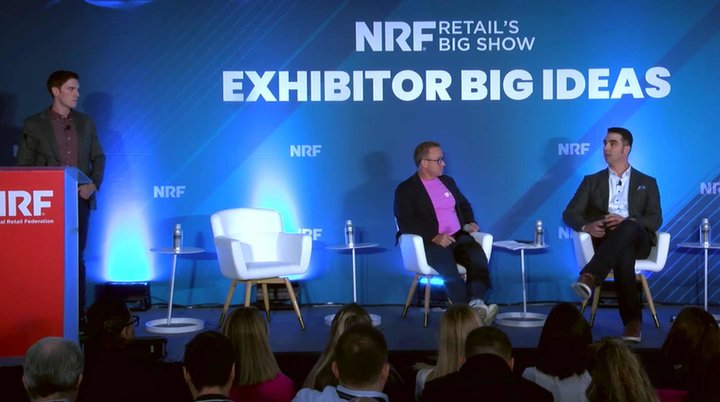How Hearst took a Pragmatic Composable Approach to Transform its Business into a Digital Marketplace

Produced by
The Hearst Corporation has interests in magazines, newspapers, and business publishing, as well as newspaper comics, features syndication and Internet activities. Well-known titles include Harper's Bazaar, Esquire, The San Francisco Chronicle and the San Antonio Express-News. Hearst also operates radio and television stations and produces television programs. The company is a partner in several cable ventures, including Lifetime, Arts & Entertainment, the History Channel, and ESPN. Hearst own 35 television stations; 24 daily and 52 weekly newspapers; digital services businesses; and more than 200 magazines around the world. As the world's largest lifestyle publisher, Hearst Magazines has a portfolio of more than 25 brands in the U.S., 175 websites and more than 200 magazine editions worldwide.
Robert Gash, Chief Technology Officer, eCommerce at Hearst, spoke extensively about Hearst's approach to offering seamless experiences across various brands it owns, emphasizing how crucial technology choices are in achieving this goal. Here's a detailed summary:
1. Emergence of Social and User Growth: Robert highlighted the importance of understanding the emergence of social media and user growth, particularly in the US market. He noted that prior to this growth, reaching the customer base and audience was easier, but with increased competition and pricing, Hearst needed to adapt. They recognized that audiences now spend time researching their decisions before committing to a purchase, and Hearst's content plays a significant role in helping users navigate their purchasing journey.
2. Diversifying Channel Strategy: Robert discussed the importance of diversifying channel strategies and not relying solely on one or two key channels. By understanding where customers spend time looking before making purchase decisions, Hearst aims to be present across various touchpoints in the customer journey, particularly in mid-funnel stages where customers are researching their options.
3. Leveraging Content Expertise: He emphasized the value of content in aiding customers' decision-making processes, especially for high consideration purchases where customers may lack expertise in a particular area. Hearst's extensive content resources, including expert reviews and research, help customers navigate product choices effectively.
4. Evolution of Commerce Strategy: Robert described Hearst's commerce strategy as an evolution built on past successes in providing editorial content. By extending this experience into commerce, Hearst aims to offer deeper and more curated shopping experiences, leveraging its expertise in various subject areas.
5. Technology Choices and Integration: He discussed Hearst's approach to technology choices, emphasizing the importance of selecting familiar tools that are easy for engineers to understand and integrate quickly. Hearst opted for solutions like VTEX for its familiarity and ease of integration, enabling faster implementation and reducing operational burdens.
6. Prioritizing Customer Experience: Robert stressed the importance of prioritizing customer experience in technology decisions, focusing on features and integrations that enhance the user journey and minimize friction. Hearst evaluates technology investments based on potential upsides and their impact on improving customer experience and operational efficiency.
7. Flexible and Scalable Solutions: He highlighted the importance of choosing flexible and scalable solutions that allow Hearst to adapt to evolving market dynamics and customer preferences. By avoiding overly complex or proprietary systems, Hearst aims to remain agile and responsive to customer needs.
8. Collaboration with Partners: Robert emphasized the importance of collaboration with technology partners like VTEX, leveraging their expertise to overcome challenges and innovate. He praised the collaborative approach taken by VTEX in addressing Hearst's needs and driving continuous improvement.
In summary, Robert outlined Hearst's strategy of combining content expertise with seamless commerce experiences, underpinned by strategic technology choices and a customer-centric approach. By leveraging technology effectively and collaborating with partners, Hearst aims to reimagine its business for the digital age and deliver value to its customers across various sectors.

Play Video

Jordan Jewell, the Senior Director and Analyst in Residence at VTEX provided the context about the state of the retail and e-commerce market, particularly highlighting the shift from the pre-pandemic "old normal" era, characterized by balanced growth and profit in retail, to the pandemic-induced era of growth at all costs. During this period, e-commerce became a significant revenue driver for many businesses as consumer behavior shifted towards online shopping. However, he emphasized that the focus on growth sometimes came at the expense of profitability.
Jordan then presented data from the Census Bureau to illustrate the transition into the era of profitability, where businesses are now placing greater emphasis on achieving sustainable profits rather than solely focusing on growth. He highlighted the importance of retailers and brands adapting to this new landscape by prioritizing margins and unit economics to ensure long-term viability.
The presentation delved into five key trends and challenges facing the e-commerce industry:
Customer Acquisition Costs: Jordan discussed how customer acquisition costs have risen significantly over the past decade, making it more challenging for businesses to acquire new customers profitably.
Challenges of Direct-to-Consumer (DTC) Model: He highlighted the difficulties faced by DTC companies in achieving profitability, citing examples of popular DTC brands that are yet to turn a profit due to thin margins and high customer acquisition costs.
Success of Chinese Companies: Jordan pointed out the success of Chinese e-commerce companies in the US market, emphasizing their innovative approaches and ability to outperform American companies in terms of traffic and market share.
Market Consolidation: The presentation discussed the dominance of top e-commerce retailers, particularly Amazon, and the challenges this poses for smaller brands and retailers in competing effectively in the online marketplace.
Choice Overload: Jordan addressed the issue of choice overload for consumers, emphasizing that an abundance of options can lead to decision paralysis and reduced conversion rates. He advocated for niche marketplaces and curated assortments as potential solutions to this problem.
Throughout the presentation, Jordan engaged in dialogue with Robert, discussing their perspectives on the challenges and opportunities presented by these trends. They explored the concept of "composable commerce" and its implications for businesses, emphasizing the importance of making strategic decisions about technology architecture and talent acquisition to drive sustainable growth and profitability.
In conclusion, Jordan reiterated the importance of embracing pragmatic approaches to composable commerce, focusing on quick implementation and measurable business benefits. He invited attendees to access additional resources, including a paper on pragmatic composability and a forthcoming business financial model, to further explore these concepts and strategies.
Mariano Gomide de Faria, the Founder & co-CEO of VTEX, discussed various aspects of the evolving landscape of commerce, particularly emphasizing the intersection of content and commerce. He highlighted Hearst Corporation's entry into e-commerce, citing their extensive reach and audience through brands like Cosmopolitan and Men's Health. Mariano coined the term "concierge commerce," envisioning a future where individuals assist consumers in navigating overwhelming choices and provide curated recommendations, thus enhancing the overall customer experience.
He also discussed the trend of convergence between content and commerce, where companies like Google and TikTok are venturing into e-commerce while e-commerce platforms like Amazon are delving into content creation. Mariano emphasized the importance of integrating content and commerce seamlessly, foreseeing it as the future standard rather than two separate categories.
Additionally, Mariano touched upon Hearst's journey into e-commerce, highlighting their lean and fast approach to launching a marketplace within a short timeframe, leveraging VTEX's technology instead of developing custom solutions. He talked about VTEX's framework, VTEX IO, for its flexibility in developing and extending solutions, advocating for a pragmatic approach to composability in building e-commerce ecosystems.
Throughout his remarks, Mariano emphasized the necessity for businesses to address complexity efficiently, advocating for simplicity in architecture to achieve high growth and profitability. He concluded by discussing the potential of influencers and conversational commerce in shaping the future of retail, highlighting examples like TikTok's emergence as a shopping platform and Four Seasons' adoption of chat-based customer service.
Overall, Mariano's insights underscored the importance of adaptability, collaboration, and innovation in navigating the rapidly evolving landscape of commerce.








